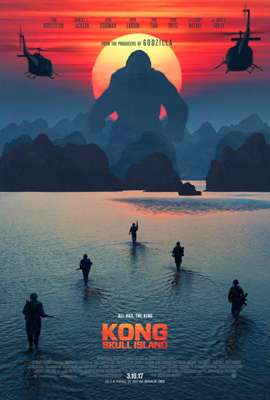 At 84 years old, did King Kong really need to be resuscitated? Of course he did, it’s a cinematic tradition- classic movie monsters are immortal.
At 84 years old, did King Kong really need to be resuscitated? Of course he did, it’s a cinematic tradition- classic movie monsters are immortal.
Given their signature film entrances, all the classic monsters wind up dying, only to be brought back to fight each other or cause more mayhem in a new time period. Ask any of the Universal monsters like Dracula, Frankenstein or the Wolf Man who, in their debut films were respectively staked, burned and shot only to be resurrected in future films because any supernatural being can find his way around a DNR if movie audiences want them back badly enough. And so it is with Kong, whose bullet-ridden body and fall from the Empire State Building in 1933 would only lead to his fighting fellow mutant monsters like Godzilla and the robot MechaKong in Japan in the 1960’s. Now, as is tradition, Kong reappears in “Kong: Skull Island,” three years after Godzilla decided to reemerge in 2014’s Gareth Edwards film. What does all this mean? That “Godzilla” and “Kong: Skull Island” are linked by screenwriter Max Borenstein, who has given both films a similar story tie-in planning to have both monsters duke-it-out in his announced script for 2020’s release of “Godzilla vs. Kong.”
I’ve told you all of this to say that “Kong: Skull Island” is fairly bulletproof from negative comments- it’s a traditional B-monster movie with great special effects and a story that serves only to revisit cinema’s favorite super-sized simian. If “Skull’s” set-up was truly unconvincing or the special effects lacking, I might find a fault. However, audiences are there for one reason: to see Kong. And Kong looks great. While some may find a downside that there aren’t more scenes with Kong, I didn’t mind- director Jordan Vogt-Roberts gives “Kong: Skull Island” some interesting visual elements to compensate for any of Borenstein’s literary lulls.
“Kong: Skull Island’s” story is standard B-movie drivel, but it’s interestingly set in 1973 which allows for hardened, homeward-bound Vietnam soldiers from the Sky Devils squadron, led by Col. Packard (Samuel L. Jackson), to be commandeered by U.S. government official Bill Randa (John Goodman) for an expedition to mine recently-discovered Skull Island for its geological resources. Adding British SAS Capt. James Conrad (Tom Hiddleston) and anti-war photographer Mason Weaver (Brie Larson) to their team, seismic charges are dropped by Packard’s helicopters upon arriving at Skull Island. While the charges are meant to allow for geologic study, they only allow for Kong to be alerted to their presence and unearth a batch of mutant monsters from beneath the ground nicknamed ‘Skull Crawlers’ (by WWII castaway Lt. Hank Marlow (John C. Reilly), who’s been a reluctant resident on Skull Island since his plane crashed there 28 years earlier). Kong, seeing the incoming horde of helicopters, swats them down like the pests they are, wincing from the stings as the copters’ blades cut into him. The copters that survive are separated to different parts of the island: Conrad and Weaver are left to journey in their respective area, meeting Marlow and the Skull Island natives that worship Kong like a god; Packard is left to sift through the wreckage for his remaining crew and learn of Randa’s true motive for visiting Skull Island- he works for Monarch (the company with the ‘Godzilla’ tie-in) and knows monsters are real.
What gives “Kong: Skull Island” some pep over the predictable is in its visuals. The aforementioned Kong’s battle with the helicopters not only shows there’s some life in Kong yet, but its scenes have a comic-book panel storyboard approach that I liked, especially when Packard and Kong lock eyes through the flaming wreckage and you know Packard is going to go ‘all-Ahab’ on him (Samuel L. Jackson’s got a great crazed stare). Also, the creatures inhabiting Skull Island are interesting: while the ‘Skull Crawlers’ are a little too ‘out there,’ audiences are treated to huge squid, carnivorous birds, a big insect that looks like a fallen tree and, in one of the movie’s best scenes as soldiers march through a bamboo field, giant spiders whose legs look like bamboo stalks themselves.
If you’re seeing “Kong: Skull Island,” you know what’s in store, but the good surprises I mentioned will make you forgive any of the stale story standards. Like Kong himself, “Skull Island’s” a B-movie where the ‘B’ stands for ‘bulletproof.’
